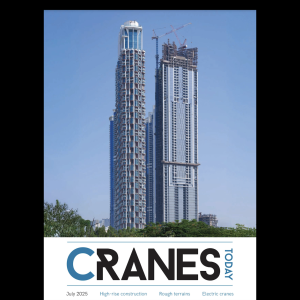
An estimated 112 million dead trees populate the Sierra Nevada Mountains. The combination of unprecedented drought over the past four years coupled with significant infestation by bark beetle has decimated trees throughout the mountain range in California. The severity of the problem caused Governor Brown of California in October 2015 to issue an Emergency Proclamation for the removal of dead and dying trees in High Hazard Zones.
Local, State and Federal agencies are in a rush to remove the trees, as the drought-stricken trees serve as kindling for the quick spread of forest fires. However, “It is slow and difficult work, as many of these trees are unsafe to climb for removal,” says Ricky Mowbray, crane operation supervisor for Mowbray’s Tree Service of San Bernardino, California. Jesse Sanchez, director of safety for Mowbray’s, adds, “Dead trees create various hazards, as they are weak and have the potential to fail more easily than a live tree. The longer a dead tree stands, the more unstable it becomes.”
Due to these challenges, few tree service contractors are answering the call for tree removal in High Hazard Zones. It is painstaking—and dangerous— work that requires attention to detail. The tree has to be climbed by an arborist carrying a chainsaw; it can sometimes take one or more days to safely remove a single tree. “If conventional tactics such as tree climbing and tying off section by section cannot be used, then we move to 100-ft (30.5-m) spider lifts,” explains Mowbray. Tree sizes range from 30 to 240 ft (7.1 to 73.2 m) tall, which poses a problem for trees too tall for the spider lifts to be safely used.
Neatly aligning with the beginning of the drought cycle in California, Mowbray’s Tree Service began a new way of tackling the problem. Over the last four years, Mowbray’s Tree Service has perfected the use of cranes for removing trees.
At first they rented their cranes, but the success they achieved has led Mowbray’s Trees Service to purchase four Demag all terrain cranes of their own. One was acquired in December of 2016 and three more in mid-2017.
The 140USt Demag AC 130-5 has a 197ft (60m) main boom length and maximum system length of 284 ft (86.5m). The 180USt class AC 160-5 features a longer, 223.1ft (68m) main boom length with 311.7ft (95m) maximum system length.
Crane reach and capacity allows workers to set up in one location to take down multiple trees. “We can remove as many as 10-15 trees in a day, whereas with other methods, we would average about one tree a day,” says Mowbray. “However, even with the cranes, we still have those jobs where we have to work at a 185ft (56.4-m) radius and it takes a day or two to remove a tree.”
Stephanie Wood, director of product safety for Terex Cranes, advises that from the safety point of view these are regarded as special circumstances. “Cranes are designed to pick freely suspended loads and lift them into position,” she says. “However, OSHA (Occupational Safety and Health Administration) and ASME (The American Society of Mechanical Engineers) both address applications in which a crane can be safely used for work such as tree removal and how to properly lift personnel in these applications.”
When there is no safe way to climb the tree, Mowbray’s Tree Service uses the crane to lift the worker into position. “The tree canopy makes it dangerous to use a platform, so we use the hook block to lift the worker when there is no other way to safely get to the tree. We use a double tie-off method, positioning a lanyard through the hook block and tie-in the sling made for climbing above the hook on the line,” Mowbray explains. The standards typically call for a platform to safely lift personnel at the jobsite, but this often is not possible when working in the High Hazard Zones. A special variance has been granted to lift a worker into the tree in this manner.
Currently, Mowbray’s Tree Service employs four trained crane operators, two of whom are company employees with prior tree removal experience. “It helps to have an experienced person in the seat to help determine sling placement and if the crane is able to handle the load” says Mowbray.
Company foremen use a green weight load chart for determining load weight. The pre-lift plan includes measuring the length and diameter of the tree section to be cut to calculate its weight and make sure it falls within the crane’s rated capacity at the boom length and radius. “To be safe, we aim for half the rated capacity, and dead trees weigh less than ‘live-tree’ weights in the chart,” says Mowbray. Even so, weights range from 6,000 to 10,000 b (2.7–4.5t) for top tree sections and increase to as much as 24,000 lb (10.9t) at the base.
Mowbray has found the most significant Demag feature for the application is the hydraulic luffing jib. “In the past, if we needed an offset to the jib, we would set it before we put it up in the air. If it wasn’t right we’d have to boom down to change the angle. Now with the hydraulic jib, we can set the offset in the air, which helps us to get to more trees in one day. It’s a real game changer.”
Wireless remote control helps crane operators when working around an obstruction. “We use two-way communication between the operator and the man in the tree, but it is sometimes necessary for the operator to see where they are working” explains Mowbray.
“The cranes add a whole new approach to our operation,” offers Sanchez. “In the four years of using cranes, we have had no serious incidents or accidents. This is a testament to crane use and the experience of our operators and arborists.”






